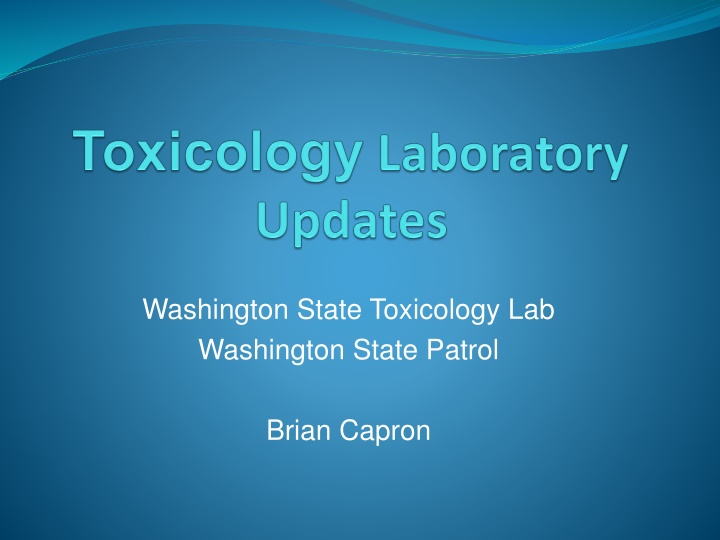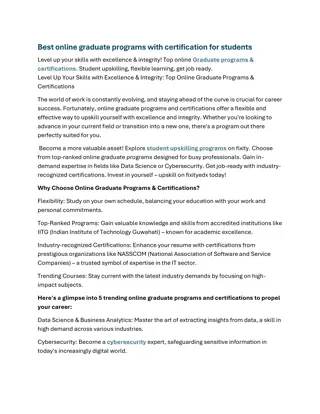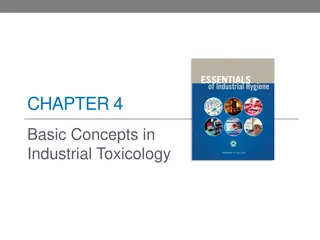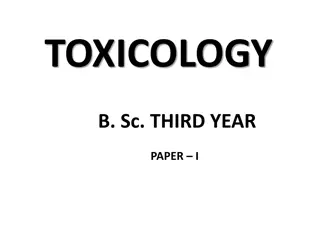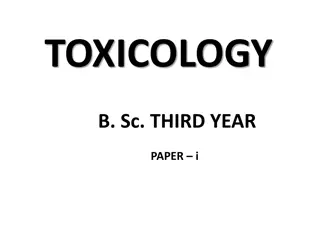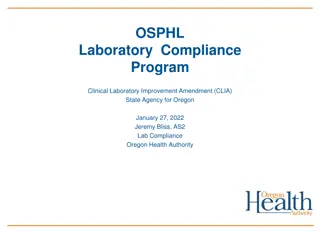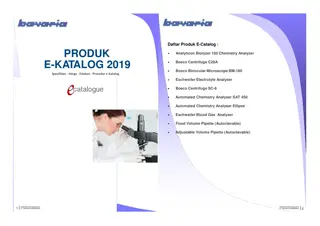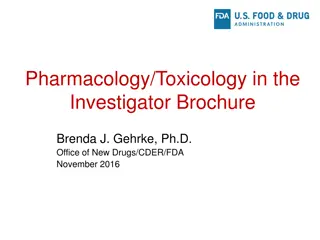Toxicology Laboratory Updates and Certifications
The Washington State Toxicology Lab, under the Washington State Patrol, has recent staffing updates, including new hires and return of staff on maternity leave. Updates on validated methods and toxicologist certifications are provided, showcasing the lab's commitment to quality and accuracy. A new testing policy effective from 2013 has been implemented. Stay informed about the latest developments in this vital field.
Download Presentation

Please find below an Image/Link to download the presentation.
The content on the website is provided AS IS for your information and personal use only. It may not be sold, licensed, or shared on other websites without obtaining consent from the author.If you encounter any issues during the download, it is possible that the publisher has removed the file from their server.
You are allowed to download the files provided on this website for personal or commercial use, subject to the condition that they are used lawfully. All files are the property of their respective owners.
The content on the website is provided AS IS for your information and personal use only. It may not be sold, licensed, or shared on other websites without obtaining consent from the author.
E N D
Presentation Transcript
Washington State Toxicology Lab Washington State Patrol Brian Capron
Laboratory Staffing Updates New Laboratory Manger: Dr. Brianna Peterson Two toxicologists still on maternity leave Lisa Noble (return November) Rebecca Flaherty (return December) Four new toxicologists hired: Amanda Chandler- finishing training Lyndsey Lowe- doing case work Katie Knorr- doing case work Andrew Gingras- in training
Laboratory Staffing Updates Currently have 7 toxicologists performing work on driving cases and testifying in trials (WA and AK) Supervisor position filled by Lisa Noble who returns next month Administrative position still open Lab will not be fully staffed until late December when last person returns from maternity leave Two new hires are doing case work (death cases) while the other two are finishing their training Dawn Sklerov has returned and will be starting case work in a few weeks
Validated Methods We have introduced over 10 new validated methods in the past few years with more in the future Validated methods undergo rigorous scientific testing to ensure that we are providing the best possible results to our customers Validation is an important necessity for laboratory accreditation Validated methods produce high-quality results that are easier to defend in court Validated methods take months to be developed and tested (time consuming)
Toxicologist Certifications Newly introduced methods require toxicologists to become certified to perform them Usually a three to four stage process First stages require testing calibrators and controls Last stages require testing spiked samples Results undergo peer review by QA department Toxicologists receive an authorization letter to perform the testing Trying to get all toxicologist to perform their own work on all driving cases (court rulings)
New Testing Policy in 2013 Effective January 1, 2013: All driving cases will be tested for alcohol and drugs regardless of alcohol level (change from the past) All vehicular assault/homicide cases will undergo full toxicology testing Causing/unknown drivers in fatalities will undergo full toxicology testing Pedestrians will undergo alcohol and drug testing All testing results will appear on reports if the test has been performed (even negative results)
New Testing Policy in 2013 Changes require the toxicologist to perform more testing on every sample (turn around times) As a result, we are seeing many more drivers with alcohol levels >.10 that also have drugs present If you suspect alcohol only, please request blood alcohol only in writing on the request form otherwise we are required by our policy to perform drug testing as well
Toxicology Lab-YTD (Jan-Dec 12) Year % change YTD 2012 YTD 2011 YTD 2010 YTD # total cases - 10,995 10,962 10,547 postmortem - 4,975 4,964 4,592 DUI/DRE 3% 5,838 5,682 5,524 other case types 43% 182 319 431 TAT-testing 3 days 13 days 16 days 21 days DUI/DRE cases 9/20 days 14/22 days 15/29 days TAT-lab report 15 days 19 days - # analysts 11 12 11 # court cases 6% 419 396 345 # court hours 6% 2,151 hr 2,292 hr 2,030 hr # discovery requests 35% 272 417 437
Toxicology Lab- 2012 DUI/DRE summary 2012 stats (N=5,838) 2011 stats (N=5,682) THC (metabolite) Methamphetamine Alprazolam Oxycodone Diazepam Zolpidem Methadone Clonazepam 18% (29%) 10.5% 6.1% 3.9% 3.6% 3.3% 3.2% 3.0% 20% (29%) 9.6% 6.4% 4.2% 4.5% 3.2% 3.9% 3.5%
Toxicology Lab-YTD (Jan-Aug 13) Year % change YTD 2013 YTD 2012 YTD 2011 YTD # total cases 3.4% 7,599 7,349 7,418 postmortem 2.2% 3,413 3,342 3,350 DUI cases 6.8% 3,373 3,159 2,932 DRE cases 16% 606 723 901 Other case types 65% 206 125 235 TAT (median) 5 days 19 days 14 days 15 days # analysts 6 FTE 6 12 12 # court cases - 294 297 252 # court hours 5% 1,529 hrs 1,608 hrs 1,459 hrs
Toxicology Lab-THC Statistics (YTD) Data Jan-July 2013 Jan-July 2012 Jan-July 2011 THC DUI/DRE cases 850 (27%) 575 (19%) 618 (17%) Percent male 81% 77% 85% Age 14-74 yr (avg 29) 16-66 yr (avg 28) 16-65 yr (avg 28) % of cases < 21 yr 27% 24% 33% THC concentration 2-77 ng/mL 1-58 ng/mL 1-59 ng/mL (avg 8.2 med 5.7) (avg 7.6 med 5.8) (avg 6.2 med 4.5) Combined with other drugs Alcohol 276 (32%) 151 (26%) 104 (17%) Methamphetamine 65 (8%) 33 (6%) 42 (7%) Alprazolam 36 (<5%) 30 (5%) 26 (<5%) Oxycodone 34 (<5%) 24 (<5%) 24 (<5%)
Toxicology Lab: I-502 Impact Marijuana-related driving cases (#) 2500 2000 1500 1000 500 0 2009 2010 2011 2012 projected 2013 Projected 2013: based on data from Jan 1, 2013 though June 30, 2013
Toxicology Lab: I-502 Impact Marijuana-related driving cases (%) 45.0% 40.0% 35.0% 30.0% 25.0% 20.0% 15.0% 10.0% 5.0% 0.0% 2009 2010 2011 2012 2013 YTD YTD 2013: Jan 1, 2013 through June 30, 2013
Toxicology Lab- THC case History 45 year old male SPD case- stopped for vehicle license violation Strong odor of marijuana in car and on subject Driver showed impairment on FST s, had watery/red eyes Admitted past Marinol use and that passenger had been smoking marijuana Testing THC 84 ng/mL carboxy-THC 720 ng/mL Comments Passive inhalation: THC <1-2 ng/mL (~20 mins) with a corresponding low carboxy-THC
Drugs we send out for testing Synthetic cannabinoids Buprenorphine (Suboxone) Lithium Risperidal Bath salts* Psilocybin Gabapentin LSD Methocarbamol Mitragynine (Kratom)*
EMIT testing limitations Testing used to see if any drug classes are positive/negative Categories include: Cocaine metabolite Opiates Benzodiazepines Barbiturates Cannabinoids Amphetamines Phencyclidine Propoxyphene* (no longer testing for) Methadone Tricyclic anti-depressants
EMIT testing limitations Class specific, not compound specific Not completely comprehensive (Ambien, Benadryl) Each drug has a cut-off level Drugs may be present below the cut-off Cut-off established through validation testing Designed to reveal clinically significant levels Some compounds cross-react (THC, Amphetamines) Some drugs are poor reactors and may not produce a positive result unless the level is significantly high
EMIT testing limitations Benzodiazepines (specific to Diazepam): Alprazolam, Clonazpeam and Lorazepam react poorly so we do confirmations on elevated responses Amphetamines (specific to Amp/Meth): Amines often do not screen positive , but we move to confirmation testing when an elevation is seen Phencyclidine: large amounts of Dextromethorphan can causes positive response (use GC/MS) Opiates (specific to Morphine): may not confirm positive if only morphine glucuronides are present
Quantitation limits Amines: 0.05 mg/L Barbiturates: 0.5 mg/L Benzodiazepines: 0.01 mg/L Cannabinoids: THC 2 ng/mL*, carboxy-THC 10 ng/mL* Cocaine: 0.01 mg/L Carisprodol/Meprobamate: 1.0 mg/L Fentanyl: 2.5 ng/mL Methadone: 0.01 mg/L Opiates: 0.01 mg/L* (HYM/6-AM: 2 ng/mL) added Oxymorphone* to the method PCP: 0.01 mg/L Zolpidem: 0.01 mg/L
Case #1 Stopped for erratic driving Strong smell of alcohol Resisted arrest and faked seizures Submitted as an alcohol only case Toxicology results: Ethanol = .25 g/100mL Hydrocodone = 0.16 mg/L Topiramate = 5.6 mg/L
Case #2 Stopped for driving on the shoulder Strong odor of intoxicants Submitted as an alcohol only Felony DUI Toxicology results: Ethanol = .12 g/100mL THC = 8 ng/mL Carboxy-THC = >200 ng/mL
Case #3 Stopped for speeding Refused SFST s Obvious signs of impairment Request form states 8 prior DUI s Submitted as an alcohol only Toxicology results: Ethanol = 0.19 g/100mL THC = 6.1 ng/mL Carboxy-THC = 100 ng/mL
Looking Forward Continue to develop new methods to detect emerging drugs seen in the driving population Electronic submissions forms and electronic reports is a future goal ASCLD/LAB accreditation Fully staffed lab within the next year New laboratory instrumentation (LC/MS/MS) Continue to increase communication between the laboratory and the DRE program
Helpful reminders Please include the DRE face sheet when submitting the sample for testing This is important because we do specific testing based upon your observations Please list the drugs suspected so the appropriate testing can be performed Remember some drugs do not react well on the initial screening Please call the laboratory if you have any questions or concerns
Questions Contact information: 206-262-6100 brian.capron@wsp.wa.gov
